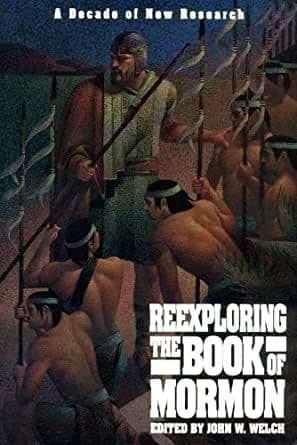Book
85 Chapters

Helaman 3:13 “And now there are many records kept of the proceedings of this people, by many of this people.“
The Book of Mormon expressly claims that its many texts and records were written by several people. Modern computers have given birth to a new science of analyzing word patterns in documents whose authorship is disputed. By wordprint analysis, it is now possible with a high degree of certainty to tell which suspected authors did not write a given work.1 Wordprinting is based on the somewhat surprising fact that every author that has been studied thus far subconsciously uses sixty-five identifiable patterns, involving words like “and,” “the,” “of,” and “that,” at statistically significant different rates from others.
For the last seven years a team of researchers has been at work refining the techniques of this “stylometry.” Recently reported work has improved the methods of counting and comparing the wordprints in different texts. The main problems found in earlier approaches seem to have been solved. Distinctive criteria emerged from 325 proof tests run on texts of known authorship (292 tests compared works of different authors; 33 compared blocks of texts written by the same author). In all cases, five-thousand-word blocks of text were used. Among the works studied were texts by Samuel Johnson, Mark Twain, Oliver Cowdery, Solomon Spaulding, and samples of Joseph Smith’s holographic and dictated writings (see Figure 1).
Also tested were the English translations of several German texts. These works were written by different German authors, but they were all translated by the same English translator. The wordprint measurement showed that each translated work was not only consistent within itself, but also clearly separable from the others, as well as from the translator’s own original English writings. This demonstrates, at least for these cases, that the uniqueness of an original author’s wordprint can survive translation.
Among the results of these studies are the following:
1. Texts written by one author typically differed from each other in respect to only one, two, or three of the sixty-five testable wordprints.
2. No two texts written by one author differed from each other in more than six tests.
3. Texts written by different authors usually manifested six, seven, or more differences or rejections. The presence of seven or more rejections was found to yield a very high degree of sensitivity in detecting which samples had been written by different authors.
4. In six tests, writings of Nephi were compared with other writings of Nephi, and writings of Alma were tested against other writings of Alma. Only one to five wordprint differences were ever found in the writings of a single author (see Figure 2).
5. In nine tests, writings of Nephi were measured against writings of Alma. In eight of these nine tests, five or more rejections resulted. Four of them produced seven, eight, nine, and ten rejections, respectively (see Figure 3 below). These results tell us that there is a 99.5, 99.9, 99.99, and 99.997% chance that the writings said to be by Nephi were authored by a different person than whoever wrote Alma’s pieces (hence Joseph Smith could not have originated both). The combined probability that the same author wrote all these texts is computed by taking one minus each of these four measurements and multiplying them all together. The result is vanishingly small.
6. Thirty-six tests were run, comparing writings of Nephi and Alma with the words of Joseph Smith, Oliver Cowdery, and Solomon Spaulding (see Table 1 below). In every set matching many texts by Nephi or Alma with texts of these three other writers, at least seven (and often many more) rejections were measured with respect to at least two (and often many more) of the ancient-to-modern comparisons run for all five of these authors. Never were fewer than three rejections found for any given single textual comparison within these sets. In thirty-one tests, six or more rejections appeared. These results yield strong statistical evidence that the wordprints of Joseph Smith, Oliver Cowdery, and Solomon Spaulding are not measurable in the tested sections of the Book of Mormon.
7. New vocabulary introduction rates are relatively level throughout the Book of Mormon, as was also found to be the case in academically translated works.
Wordprinting is an objective measurement. Its significance may well be debated, but its detection of phenomena in a text cannot be argued. The group that developed the measuring techniques for these studies came from varying religious and philosophic backgrounds (agnostic, Jewish, Mormon), yet they achieved consensus regarding the techniques used to measure the wordprint data.
The reports now available provide far more information than can be summarized briefly.2 At the bottom line, the report concludes that people who pay attention to wordprint studies can no longer speculate that the Book of Mormon consists of writings by Joseph Smith, Solomon Spaulding, or Oliver Cowdery. Such a notion is now statistically indefensible. Moreover, the didactic writings of Nephi and Alma are statistically independent from each other. While further stylometric studies are yet underway, a simple (if not the simplest) explanation of all this data is that the Book of Mormon was indeed written by different original authors and translated by a single translator with a restricted working vocabulary.
Based on research by John L. Hilton, September 1988.
1. See generally Andrew Q. Morton, Literary Detection (New York: Scribner’s Sons, 1979).
2. In part, see John L. Hilton, “Some Book of Mormon ‘Wordprint’ Measurements using ‘Wraparound’ Block Counting” (Provo: F.A.R.M.S., 1988). See also John L. Hilton, “On Verifying Wordprint Studies: Book of Mormon Authorship,” BYU Studies 30 (1990): 89-108.
Book
85 Chapters
Items in the BMC Archive are made publicly available for non-commercial, private use. Inclusion within the BMC Archive does not imply endorsement. Items do not represent the official views of The Church of Jesus Christ of Latter-day Saints or of Book of Mormon Central.